Review: Moog Matriarch
If you’ve ever fancied a modular with polyphonic tendencies, Moog’s latest multi-coloured cable-swap might have you turning from Mono to Poly.
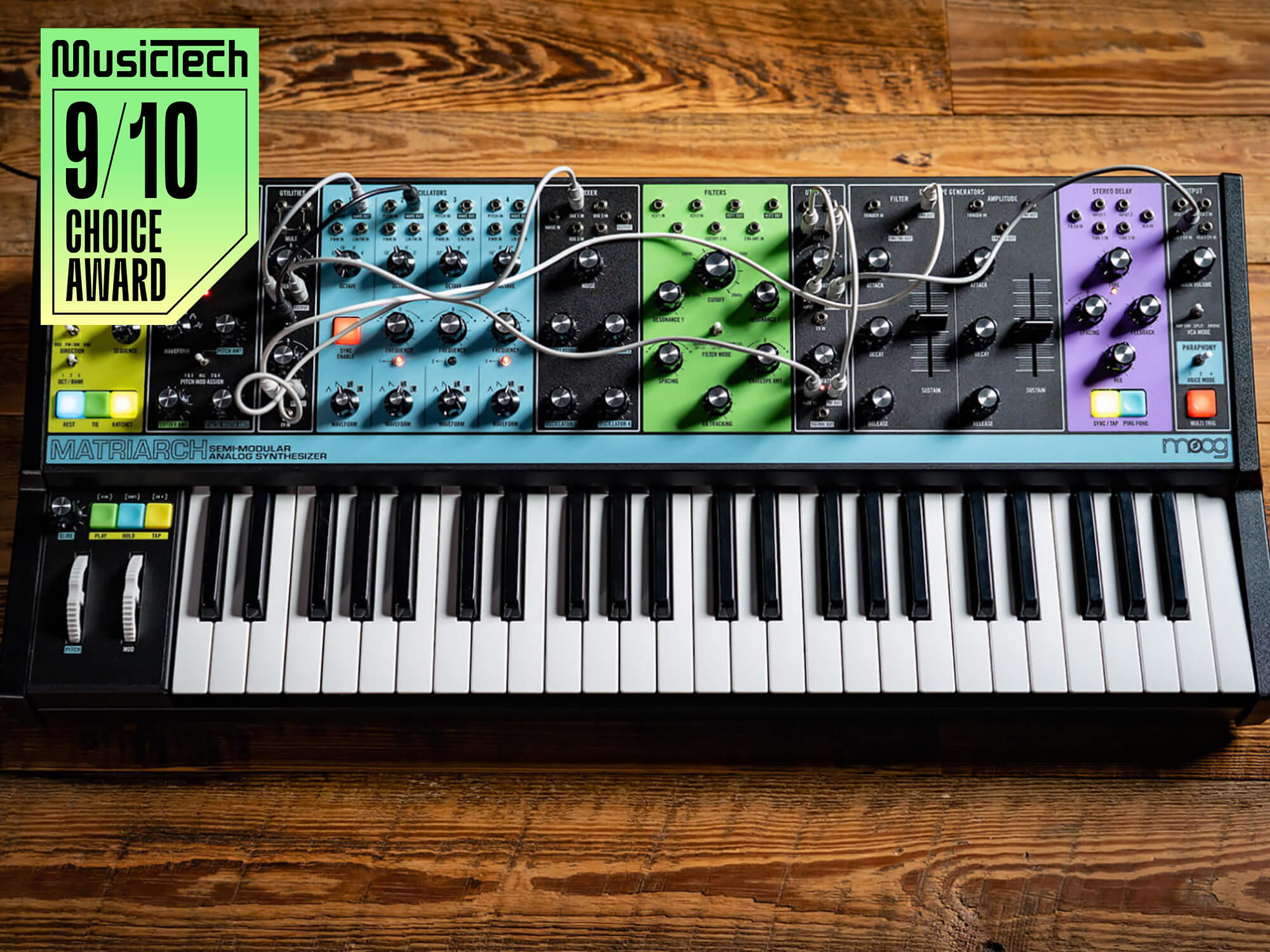
Review Overview
Our rating
9
Our verdict
⊕ Plenty of creative potential, in both musicality and the more abstract
⊕ Multiple operational modes offers greater usage potential
⊕ Beautifully built and oozing with quality, both in build and sonics
⊖ Global settings add plenty of value, but are more complicated to get to
⊖ It’s not cheap, but then quality costs!
If you like creative synthesisers, this is a machine which will be very difficult to ignore. The added bonus features merely add to its status as an object of desire.
Price £1,959
Contact Moog
Choosing a hardware synth can sometimes feel a little bit daunting. There’s always going to have to be a really good reason for handing over a fair wad of cash, rather than simply heading for the cheaper alternatives that are available today. Thankfully, if there’s one thing that you can guarantee from Moog, it’s that the company’s hardware will be well made and sound excellent, but does it sound good enough to warrant the additional expenditure? Your decision may well be swayed by any additional functionality, and in the case of the new Matriarch, you effectively get a monophonic, duophonic and four-note polyphonic synth in one machine, with a large number of other facilities, such as modular-style patching and an onboard sequencer.
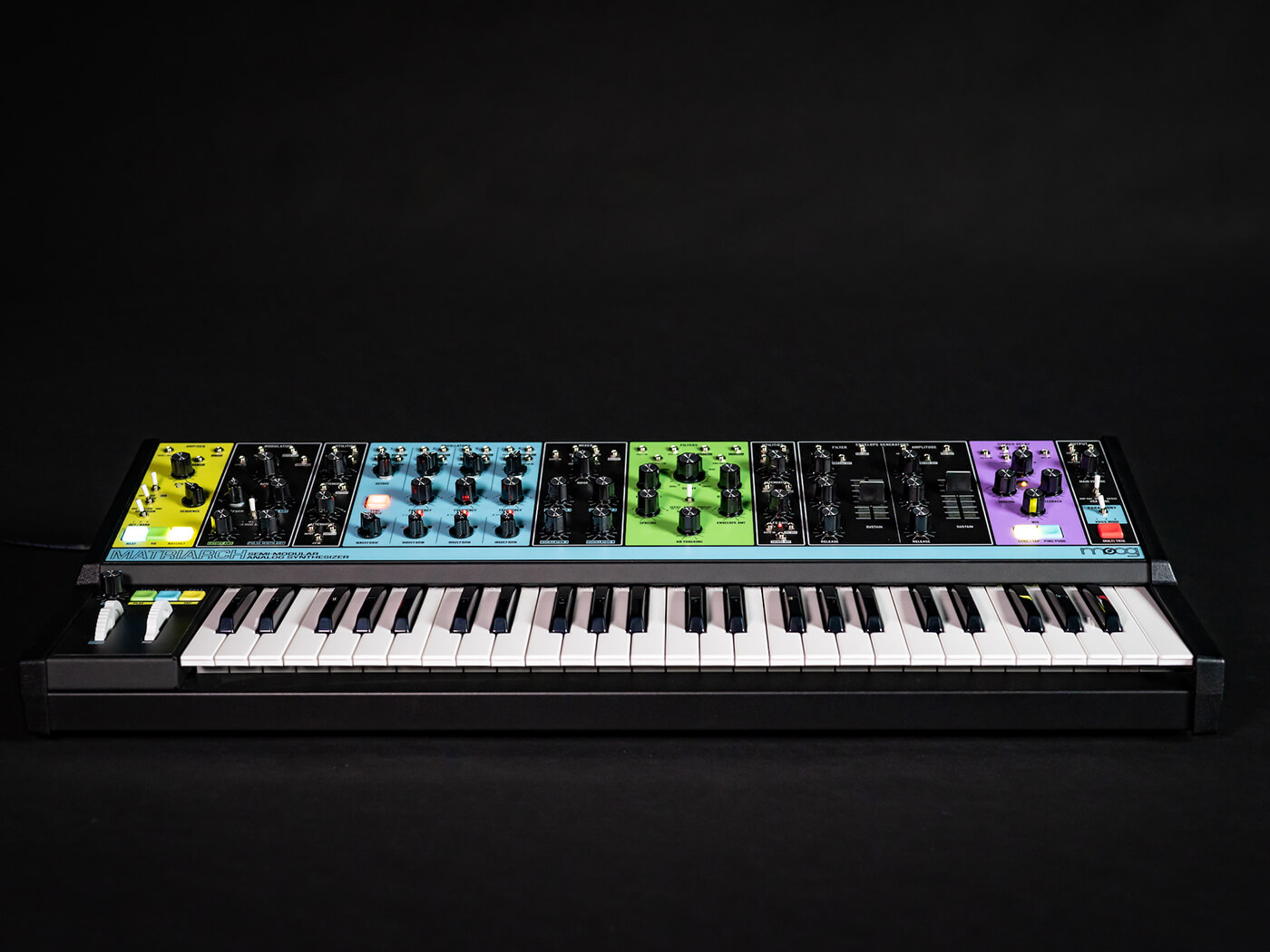
The head of the family
When Moog announced the grandmother semi-modular, there were some very mixed feelings evident from the synth community, not least of all for its rather interesting colour scheme, which some considered a little garish. This colour scheme carries through to the Matriarch, but there are a number of things to unpick here; despite the look of compartmentalisation, the numerous synth elements are firmly mounted within, not being separate module entities, and as for the choice of colour, I can’t say that it’s any more outlandish than some synths that offer an almost radioactive sense of lighting when you first switch them on. In fact, once you’ve lived with it, the colour scheme not only grows on you, but actively guides your way, with a certain reassurance that the green section will be the filter.
External decoration to one side, you will be immediately struck by the weight and build of this machine. Similar to its smaller sibling, the Matriarch is housed in a complementary mixture of metal chassis with plastic ends. Don’t be fooled by the colour scheme, there is plenty of quality here, reassuringly heavy when you pick it up, with pots that feel nicely dampened and expensive. In fact, it’s everything you would expect from a Moog, finished off with a quality Fatar keyboard and mod wheels, with traditional Moog-style pots throughout. The exception being the sustain faders, located within the dual envelope section, which are both long-throw style. Curiously, these feel unbelievably loose, although not lacking in quality, just very loose indeed! It’s almost as they were intended for some form of DJ mixer form of use, but I can’t quite work out why.
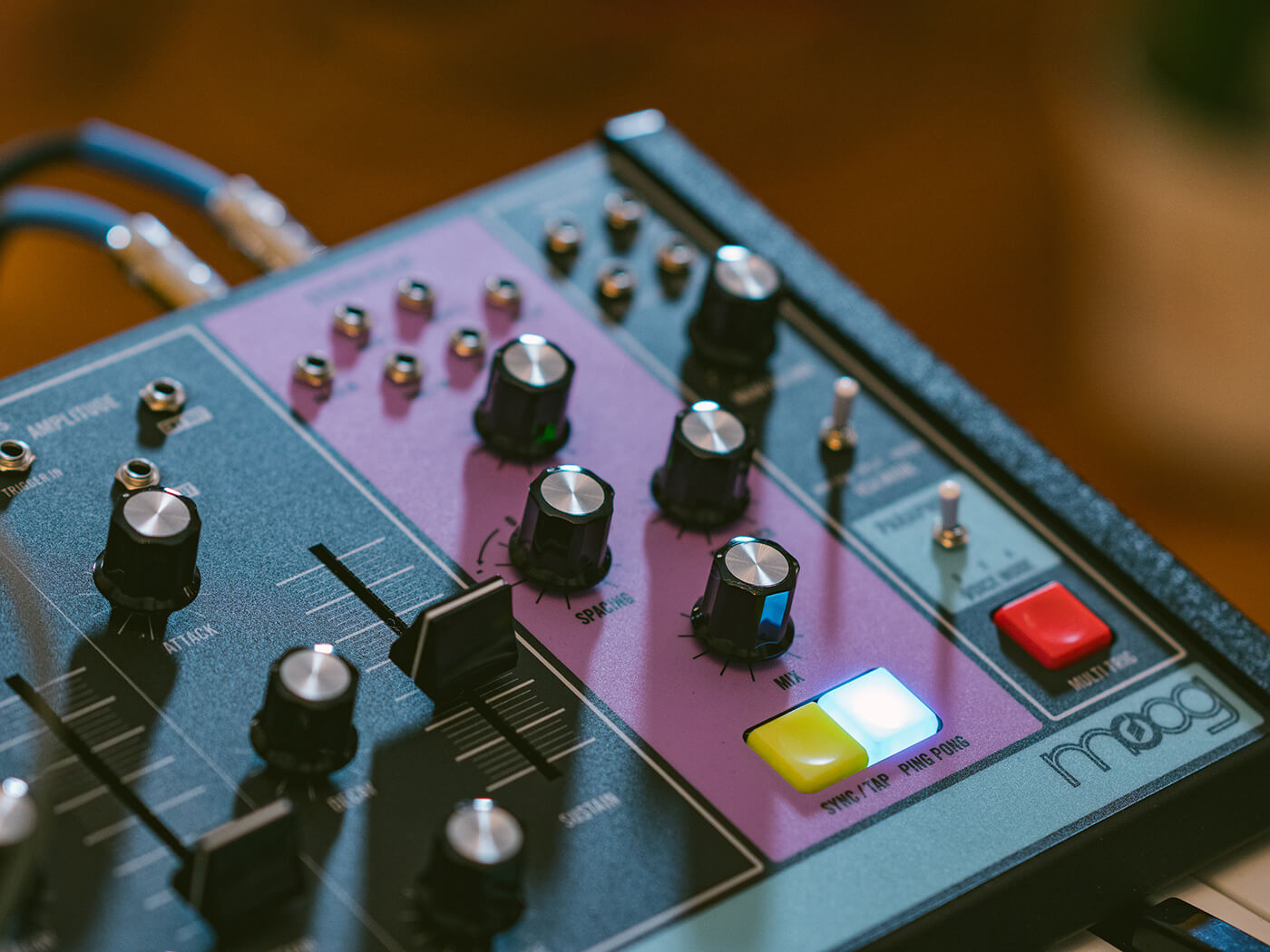
Para-para-paraphonic
The Matriarch is designed to be very flexible in a number of ways, and there’s no better indication of this than its voice mode. It’s equipped with four fully-fledged analogue oscillators, drawing architectural inspiration from machines such as the Korg MonoPoly, where the name itself offers an abundance of clues. The four VCOs can be configured to create a single layer monophonic note known as Unison Mode, or can be split into two-note duophonic mode, or taken further to a full four-note polyphony. Selection is very easy, thanks to a flick switch on the far right of the keyboard.
Regardless of which mode you choose to work with, you only have these four VCOs to deploy, so in Unison mode you can create a monster of a tone, layering up to all four of the VCOs to create something thick, ‘phat’ and full of analogue goodness. Place it into four-note poly mode, and each voice will be assigned to a note that you play, meaning that your tone will be thinner, without the ability to fatten each note as you might with bigger more expensive poly’s. There are global setting modes available for altering this behaviour, but you cannot exceed the four VCO capacity.
Moog has called upon the time-honoured mode of operation which is known as Paraphonic. This differs slightly from more conventional poly’s again, by sharing important elements such as the envelope. What this means in practical terms is that as you play more than one note in poly-mode, the first note played and last note released follow the assigned envelope shape, with all other notes piggy-backing on the existing shape which is in play. It can be a limitation, but history has shown us that it can also be very characterful, creating a certain sound which is unique and very endearing.
Through access to the Global Settings, it’s possible to change various aspects of the Matriarch’s behaviour, with one such aspect being use of Paraphonic Unison. This means that as a single note is played, the four VCOs will immediately stack, thinning out as further notes are played and stolen for corresponding notes in a chord. This again provides a characterful element to the Matriarch’s design, but with the absence of any display, global settings are altered through the pressing of multiple buttons, pressing of note-keys, and watching onboard lights which will flash. This can be rather cumbersome, and certainly not something you’ll remember very easily, so keeping the manual to hand will be essential if you feel that you want to explore this regularly.
Settings may be applied for everything from MIDI settings, to VCO frequency knob range and note behaviour, and a whole lot of other settings, significantly increasing potential. It conforms to the classic under-the-hood operational policy that we’ve seen on some other Moog products, but lacking a display can make this a bit of a challenge.
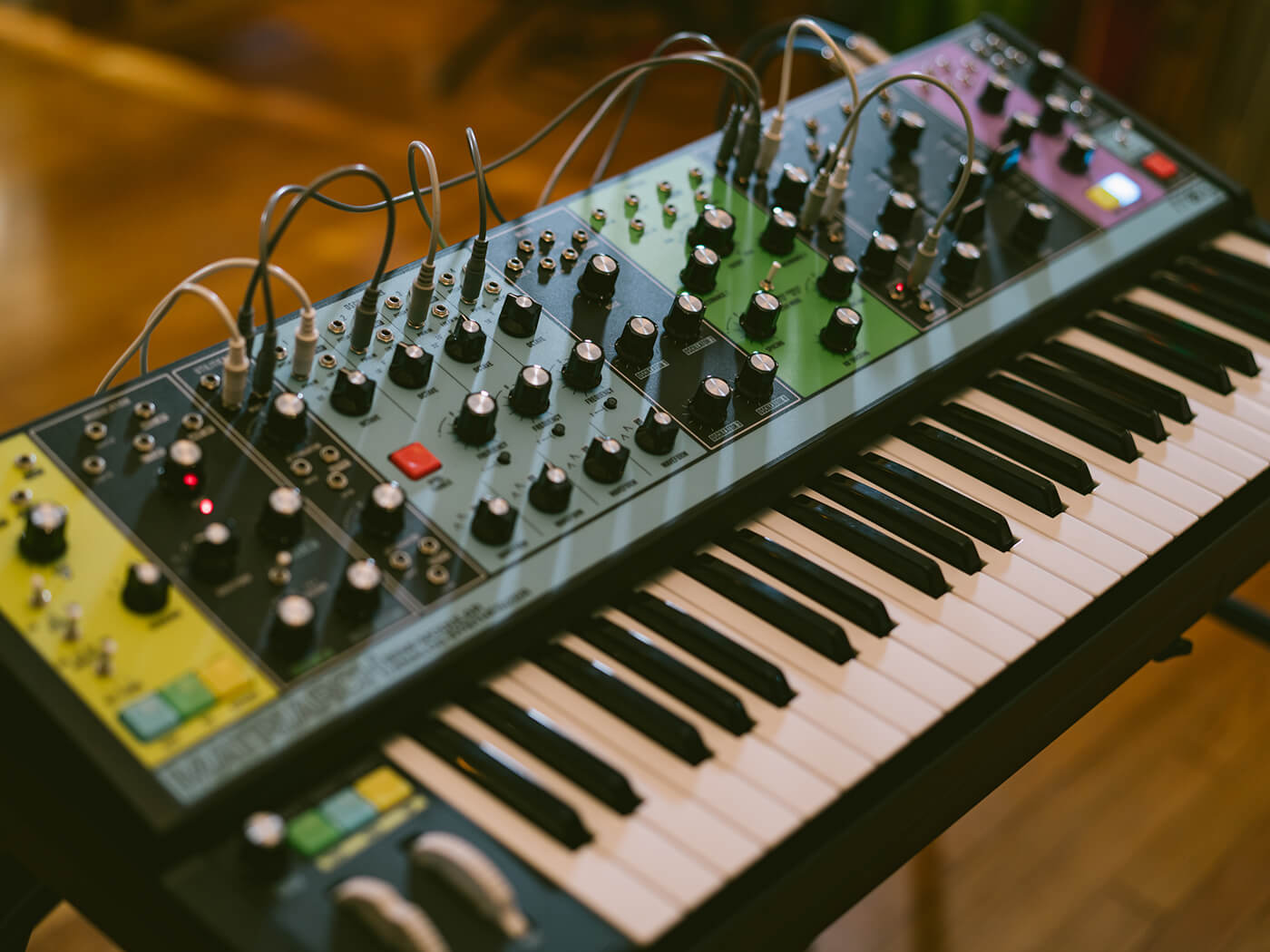
Starting over
Time for the main event. Diving headlong into the oscillator section, each of the four VCOs is identical, allowing a waveform choice from saw, triangle, narrow pulse and square, with the latter two being available to pulse width modulation. The VCOs may be individually altered in range, to one of four settings, while the latter three VCOs offer detuning, with the first VCO being aligned to the master tuning held globally. Each of the VCOs are fed into a simple mixer, with each having a dedicated volume pot, with an additional pot for adding noise.
It is the single-knob-per-function that makes the Matriarch so appealing, and increasing the volume of each VCO in turn, while in Unison mode, confirms what we probably already knew. It sounds earth-shatteringly good, with the up-front waveforms being secure in tuning and full of harmonic goodness. The Sync Enable button, located in the VCO section, allows for those classic sync tones to effortlessly emanate, but with the additional trick of allowing each VCO to sync to the next, which makes for a unique and different tonal construct.
We can’t discuss the tone of this machine without talking reverentially about the filter; its heritage is from the 904A module design, which harks back to the large Moog Modular systems from the 60s. This offers the listener a tone which does feel more colourful and vintage and can feel slightly at odds when compared to more modern designs. I have to admit that I had my doubts when I first heard the Matriarch, as it felt just a little bit too vintage for the sound world that I currently reside in, but I have to hold my hands up and report that having had the machine in the studio for a couple of weeks, my fondness for its tonal colour has multiplied exponentially.
It sounds deep and classy, with a slightly darker graininess of tone which is ripe for basses and far more besides. It does suffer from the classic ladder filter issue of lower frequencies disappearing upon the application of resonance. This is always where some form of overdrive can help nourish the bottom end, which is sadly lacking from the Matriarch, but what it does offer is a stereo signal path from the point of the filter onward.
Like previous designs from Moog, the filter can be split into a dual low pass filter which can then be spaced at differing cut off points. This is one of my most prized production details which I exploit continually, from my Moog Voyager, and allows for the creation of some stunning effects across the stereo spectrum, with a sense of sweeping across the soundstage. It’s also possible to place the filter into HP/LP mode, in either series or parallel. This means you effectively have an option for band-pass filtering, when placed in series, or you can split these to a left/right configuration when used in parallel. You do start to find yourself feeling greedy and wishing there were dual cut off pots to match the two resonance pots, although the Matriarch has a trick up its sleeve that we’ll come back to shortly.
A dedicated filter ADSR envelope, which resides alongside the amplitude envelope, can also be sent in the direction of the cutoff, with an amount control which allows for positive and negative polarity.
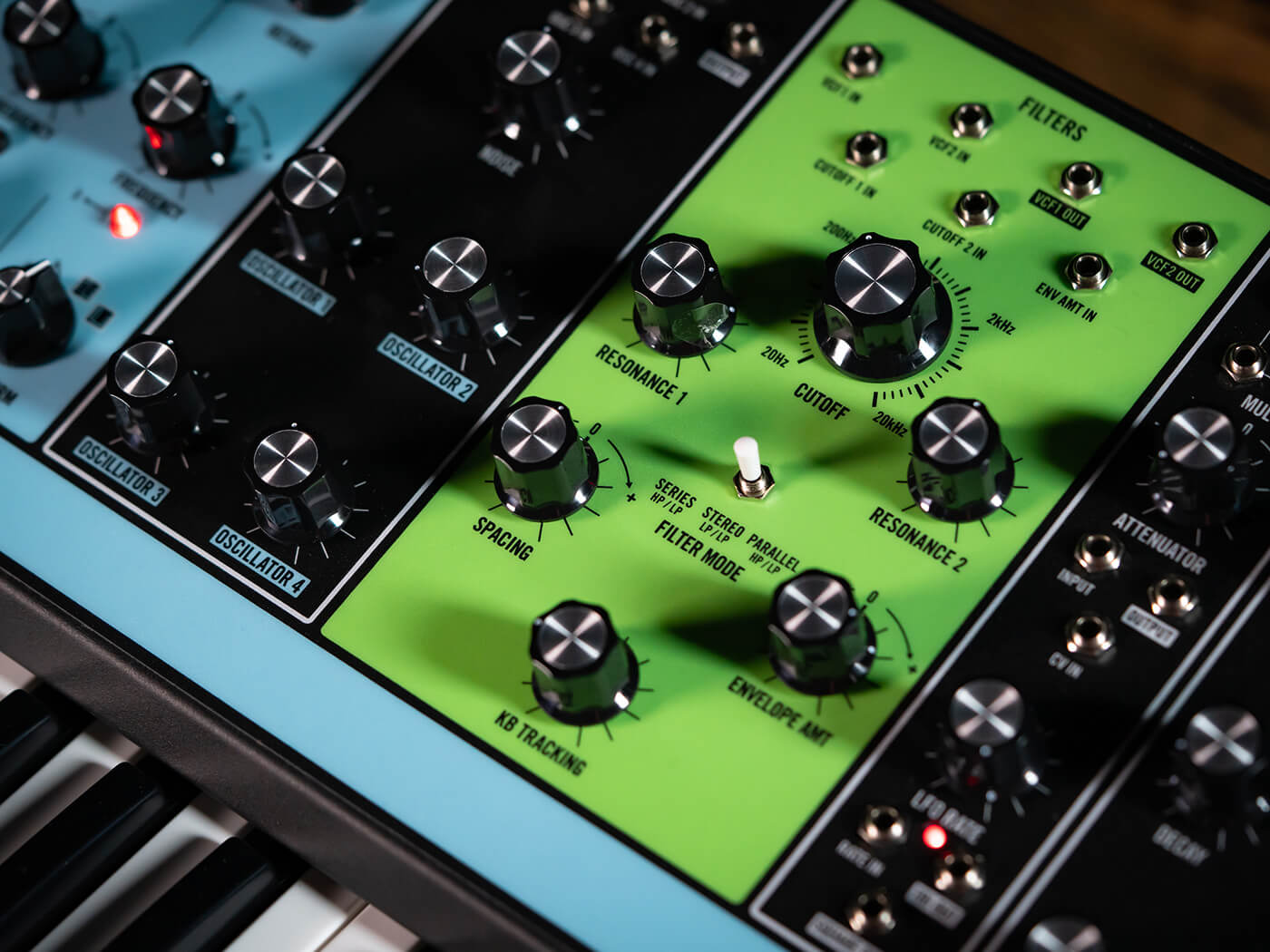
All mod cons
Everything we have examined so far is available to hard-wired operation, which is to say that you’ll not need to reach for a patch cable to implement basic synthesis duties. While this will make it useful for practical deployment in situations where you might not want the hassle of more cables, the Matriarch is something of a modular rabbit hole, which absolutely invites experimentation.
There are an abundance of patch points, both within the synth module sections and on the rear panel, all being logically laid out, with the now-familiar Moog design of outputs being ‘blocked’ in typeface. Good reasons why you might want to explore this arena becomes apparent when you wish to apply modulation, of which there are several sources. Two LFOs are available, one of which is a simple triangle and square wave design, while the other offers six waves, which includes a slewed random and staircase. The latter is superbly interesting, stepping upward and downward, depending on application to your desired point of patching.
You’ll remember that I expressed how marvellous it would be to have dual control of the filter when in parallel mode. Well, thanks to patching possibilities, this is exactly what we can create. Within the filter section, there are dedicated patch points for VCF1 and VCF2, meaning that it is possible to modulate their behaviour independently, albeit with a degree of reverence back to the main cut off pot.
To further shore up this potential, like a wise sage, Moog has included two utility modules, which are equipped with Mult’s and Attenuverters. These are a firm staple of the modular world; Mult’s allow for the splitting or multiplying of signals so that modulations can be sent in multiple directions, while Attenuverters allow modulating signals to be controlled in both amount and polarity, so their active inclusion here underlies the Matriarch’s concept and intention, while being incredibly useful too.
Despite having a fairly diverse and large modular of my own, I found myself drawn in by the Matriarch’s construct, partly as it offers a very beautiful tonal centre, but also because it feels contained, manageable and immediate, which is not something that can always be said of modular if you want to create sounds that you can just get on and play from a keyboard.
Away from the more modular biased inclusions, the spring reverb which adorned the Grandmother has been removed to make way for an analogue stereo delay. I had nothing against the spring, but this feels more suited to the concept, with true stereo performance and easy clocking to the Matriarch’s internal clock. Not surprisingly, it sounds simply amazing, with another spacing control to maximise the effect within the stereo spectrum. A simplistic timing control will free-wheel or lock into the synth’s clock, providing division accordingly. This fits in perfectly with the arpeggiator and polyphonic sequencer, clocking simply with immediate effect.
While we are on the subject, the arpeggiator is fairly basic, with three settings for motion, while the sequencer is versatile and immediate. It’s possible to step-enter up to 256 steps, which are saved in three banks of four locations. Apart from the obvious basic step entry, it’s very simple to apply rests, ties and ratchets to steps, and then alter these while the sequence is in play. Sequences can then be transposed via the keyboard, while the patching will allow for clocking of LFO, alongside the hardwired clocking of the delay. Hey presto – It’s electronic music creation personified!
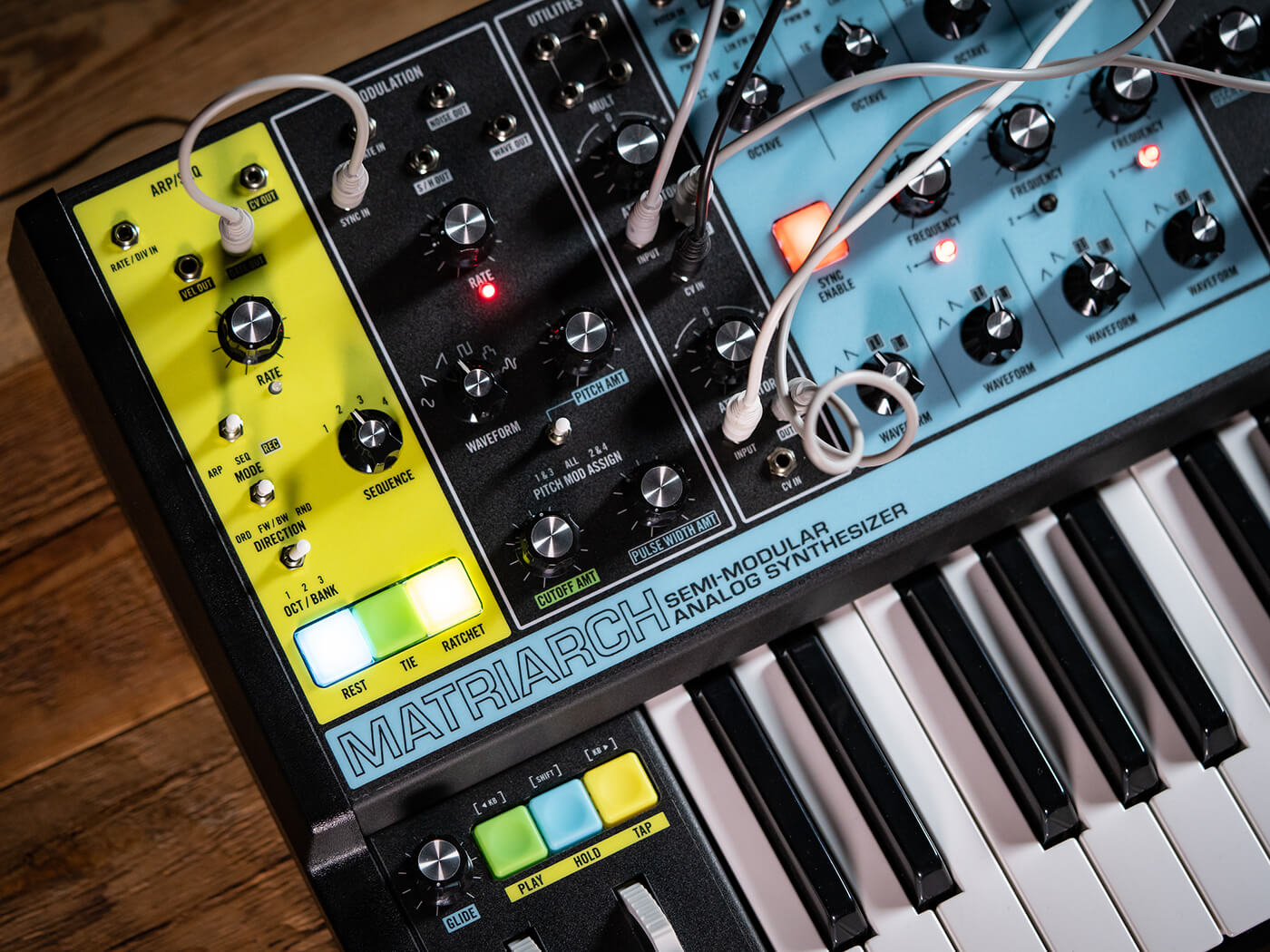
Mum knows best
When I first caught a glimpse of the Matriarch, I was slightly unsure, both in terms of its filter choice and its sheer physical presence, but having lived with it I have to hold my hands firmly aloft. It is one of the most endearing and creative machines that I have had the opportunity to explore in recent times.
The polysynth side of this machine should be considered more of a fringe benefit, which is nice to have as an option, but much like a multi-oscillator monosynth, it oozes Moog reverence and appeal that makes it sound retro-modern, ripe for contemporary production and vintage-cool. Carrying that Moog kite mark means that you’re buying into a truly wonderful brand, but much like a good quality German car, it comes with that slightly higher price tag, which might make some regrettably think twice.
Do I really need this?

This is a truly beautiful beast with many heads, which has creativity at the very soul of its being. It predictably has that vintage Moog sound, while being highly adaptable and incredibly creative, which invites its use in the studio and as a live machine. The alignment of oscillators allows for some really interesting use when exploited via the arpeggiator and sequencer; setting different waveforms and pitch ranges across the four VCOs brings unpredictability, which is highly desirable for music creation.
As a mono machine it’s superb, while the poly operation sounds just fine, but depending on what you’re after, you might find that the addition of some form of chorus might help thicken the poly-texture. However, the one thing that is for sure is that it’s completely possible to get lost in its sounds and architecture. Grab a patch cable and get busy, and while you’re there, it’s a great controller for a Eurorack system!
Key features
- Four-note paraphonic analogue synthesizer
- Semi-modular design allows for patched and unpatched use
- Ninety patch points for more complicated sound creation
- Patchable and compatible with other Moog modular products and Eurorack
- Beautiful Moog stereo ladder filters
- Built-in arpeggiator and sequencer (256 steps)
- Stereo analogue delay onboard
- MIDI connectivity via USB or regular 5-pin din
Alternatives
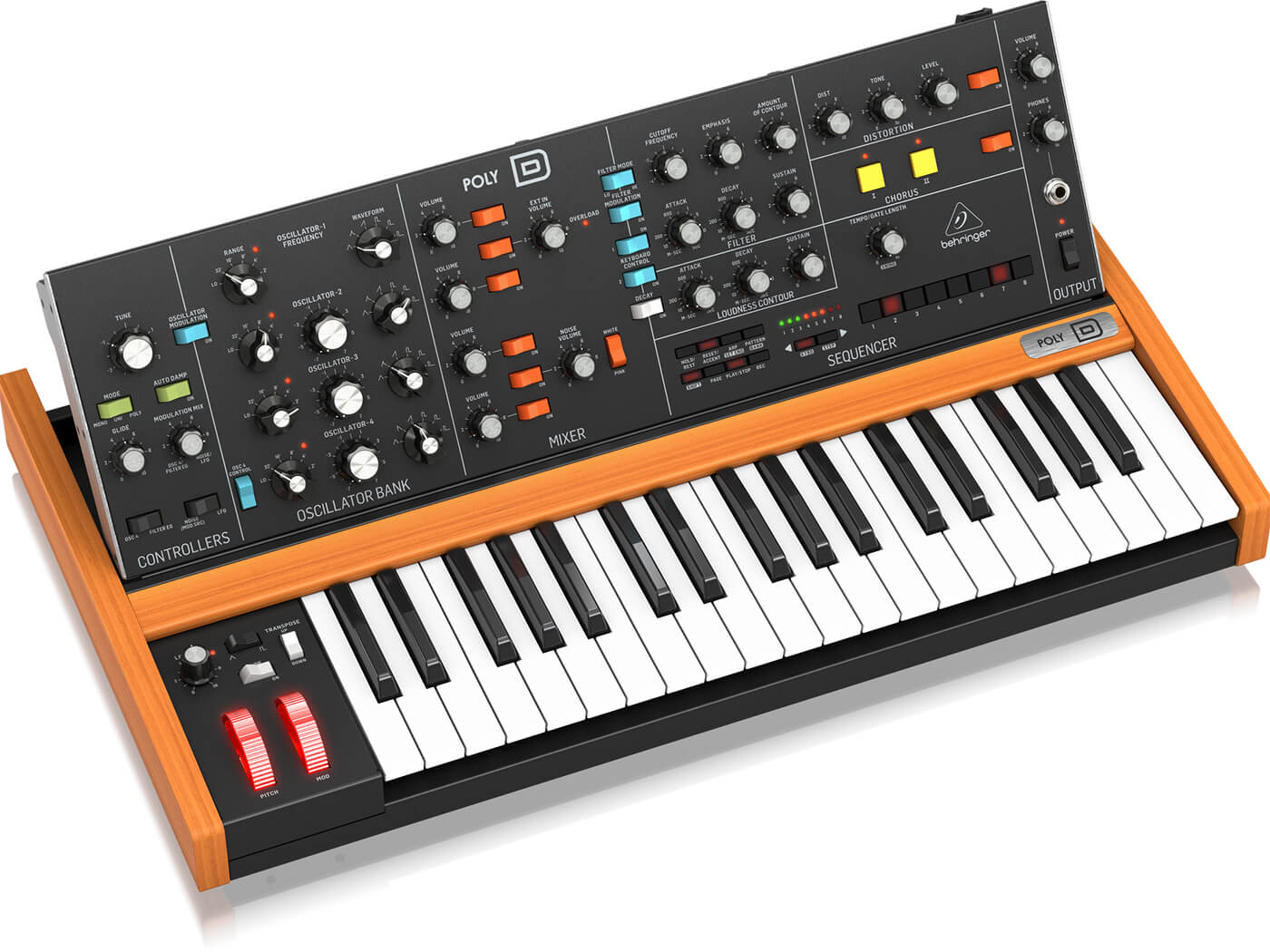
Inspired by the Model D, Behringer have taken the basic concept of this version and added four-note polyphony, in a machine that looks very reminiscent of the original MiniMoog. It lacks the semi-modular construction of the Matriarch, but offers a similar MonoPoly VCO assignment.
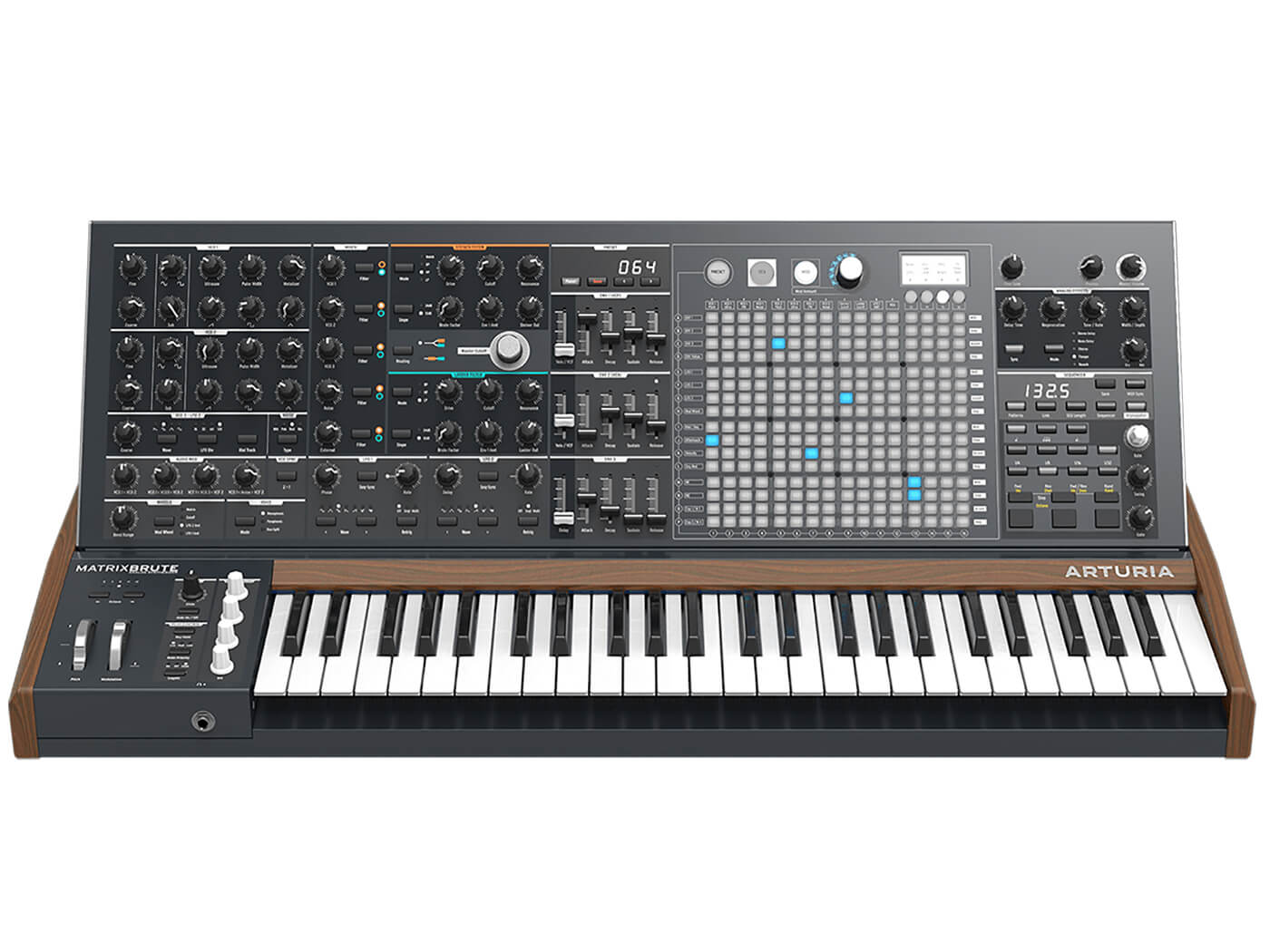
Arturia
MatrixBrute £1,699.00
While the MatrixBrute is not exactly semi-modular, it does have a very clever routing system that allows for incredibly complex modulation. Ultimately, it is a Monosynth, but it can deploy its three oscillators paraphonically, offering up to three notes from the corresponding VCOs.